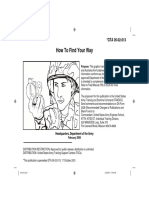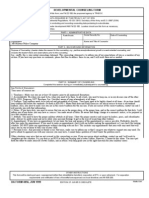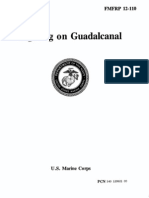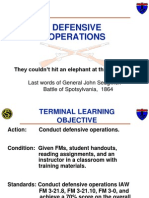2023 Promotion Board Study Guide
2023 Promotion Board Study Guide
Uploaded by
api-256305755Copyright:
Available Formats
2023 Promotion Board Study Guide
2023 Promotion Board Study Guide
Uploaded by
api-256305755Original Title
Copyright
Available Formats
Share this document
Did you find this document useful?
Is this content inappropriate?
Copyright:
Available Formats
2023 Promotion Board Study Guide
2023 Promotion Board Study Guide
Uploaded by
api-256305755Copyright:
Available Formats
1
Created on 03/28/23 - C/LTC Krishelle Arias-Torres and C/MAJ Shayla Lopez-Cardenas
Property of the Phillip O. Berry JROTC Fighting Cardinal Battalion
Phillip O. Berry
Cardinal Battalion Study Guide
JROTC
Subject: Promotion and General Knowledge Study Guide,
To: All Cardinal Battalion Cadets
1. This booklet is designed to assist you in preparing for promotion
boards and help ensure that you possess the necessary skills and
knowledge required of cadets.
2. You are only limited by your will to achieve. Only those cadets that
demonstrate their abilities and possess the necessary knowledge
will be promoted to the next higher grade.
3. The questions listed in this booklet will be asked during promotion
boards, weekly inspections, and the Annual Formal Inspection (AFI).
4. For instructions regarding the areas you should study, coordinate
with your chain of command.
-JROTC Promotion Board Study Guide-
2
Reporting In/Out: Cadets must observe proper reporting procedures
when reporting in and out of the board. Cadets will follow the following
steps:
a. Knock on the office door and wait for permission to enter.
b. March in, stand two paces from the instructors.
c. Stand at attention and render a hand salute.
d. Report in by saluting and stating “Sir/ Ma’am, Cadet (Last Name),
reporting to The Board as ordered”.
e. Wait for the senior instructor to return your salute and then drop
yours.
f. When all business is finished, stand at attention, render a salute and
ask for permission to leave the board.
g. Wait for the instructor to return your salute and exit the office.
INTERVIEW QUESTIONS
1. Have you ever disliked something about the battalion? If so, what? How
would you correct it?
2. Do you work well with other people?
3. Do you work well under pressure? What do you do when stressful
situations come up?
4. Are you willing to dedicate time to the battalion’s success and be a
present face and influence within the battalion?
Drill and Ceremonies
1. What is drill designed to teach?
Answer: Discipline/Teamwork.
2. What is the only command in drill where you step off with the
right foot “from the halt?”
-JROTC Promotion Board Study Guide-
3
Answer: Right Step, March.
3. What are the four types of commands used in drill?
Answer: a. Two-Part Commands.
b. Combined Commands.
c. Supplementary Commands.
d. Mass Commands.
4. When marching, on which foot is the command of execution
given?
Answer: On the foot in the direction of movement. E.g. Left Flank, March –
the preparatory command and the command of execution are given as the
left foot strikes the marching surface.
5. When marching, after receiving the command of execution,
what are your actions?
Answer: Take one additional step and execute the movement.
6. What are the four rest positions used in drill?
Answer: a. At Ease.
b. Stand at Ease.
c. Parade Rest.
d. Rest.
-JROTC Promotion Board Study Guide-
4
7. What would the commander say to revoke a command?
Answer: As you were.
8. What can you do, and not do while at the position of “At
Ease?”
Answer: You are not allowed to talk, however you may move as long as
you do not move your right foot.
9. What is drill?
Answer: Drill is specific movements and commands used to move a unit
in an ordinary manner.
10. What is distance?
Answer: The space between elements, when elements are one behind the
other.
11. What is alignment?
Answer: alignment is the arrangement of several elements on the same
line.
12. What is cover?
Answer: Cover is defined as aligning yourself directly behind the person
in front of you.
-JROTC Promotion Board Study Guide-
5
13. What is a drill command?
Answer: An oral order of a commander
14. Name four commands in which the “PREPARATORY”
command and the command of “EXECUTION” are combined.
Answer: a. At Ease.
b. Fall in.
c. Fall out.
d. Rest.
15. Which foot is the preparatory and the command of
execution given on for “REAR MARCH?”
Answer: Right.
16. What commands can be given to change the direction of
the march 90 degrees to the right or left?
Answer: a. Column Left.
b. Column Right.
c. Left Flank.
d. Right Flank.
e. Left Turn.
f. Right, Turn.
-JROTC Promotion Board Study Guide-
6
17. When required to exit a formation, what are your actions?
Answer: Take one 15-inch step to the rear, and exit the nearest flank.
18. How many counts are there in “Left Face?”
Answer: Two.
19. What is most of the Platoon Leader in a line formation?
Answer: Six steps in front of and centered on the platoon.
20. What is the post of the platoon Sergeant in a line
formation?
Answer: One step to the rear of the platoon and centered on the platoon
leader.
21. What are your actions when given the command “Dress
Right, Dress?”
Answer: Raise your left arm parallel to the ground, fingers extended and
joined, palms facing downward. Position yourself until your fight shoulder
touches the fingertips of the person to your right, at that same time, turn
your head and eyes to the right.
22. What command is given to returning to the position of
attention from “Dress Right, Dress?”
Answer: Ready, Front.
-JROTC Promotion Board Study Guide-
7
23. What are the actions of each squad when receiving the
command of “Open Ranks, March?”
Answer: a. 1st Squad takes two 30-inch steps forward.
b. 2nd Squad takes one 30 inch step forward.
c. 3rd Squad stands fast.
d. 4th Squad takes two 15-inch steps to the rear.
30. What are the actions of each squad on the command of
“Close Ranks, March?”
Answer: a. 1st Squad takes four 15-inch steps to the rear.
b. 2nd Squad takes two 15-inch steps to the rear.
c. 3rd Squad stands fast.
d. 4th Squad takes one 30-inch step forward.
31. What is a step, and how is it measured?
Answer: 30 inches, measured from heel to heel of the marching man.
Drill And Ceremonies Performance
Each cadet must be able to execute the movements listed below in
accordance with FM 3-21.5:
-JROTC Promotion Board Study Guide-
8
a. Present Arms
b. Order Arms
c. Left Face
d. Right Face
e. About Face
f. At Ease
g. Stand at Ease
h. Attention
i. Parade Rest
First Aid
1. How do you bandage a stomach wound?
Answer: Loose.
2. How do you bandage a chest wound?
Answer: Tight.
3. Would you give a casualty with a stomach wound a drink of
water?
Answer: No.
4. Would you give pain medication to a casualty with a head
wound?
Answer: No.
-JROTC Promotion Board Study Guide-
9
5. What is the purpose of first aid?
Answer: To save lives by providing basic lifesaving skills.
6. What are the four techniques for controlling bleeding?
Answer: a. Elevate the wound.
b. Direct pressure.
c. Pressure points.
d. Tourniquet (last resort).
8. What are the two types of first aid?
Answer: a. Physical.
b. Psychological.
9. How would you treat a casualty for a shock?
Answer: Lay the casualty down, loosen restrictive clothing, elevate the
feet and keep the casualty warm.
10. How soon could a casualty that is not breathing die?
Answer: 4 to 6 Minutes.
-JROTC Promotion Board Study Guide-
10
11. When administering CPR and being assisted by another
person, what is the compression-to-breath ratio?
Answer: (5 to 1) 5 compression to 1 breath.
12. When applying CPR (unassisted) what is the breath
compression to breath ratio?
Answer: 15 to 2 (15 compressions to 2 breaths).
13. How would you treat a casualty with a first-degree burn on
the hand?
Answer: Place a hand under cool running water, bandage loosely and
seek medical attention.
14. What are the symptoms of heat stroke?
Answer: Dry hot skin and high temperature.
15. What are the symptoms of heat exhaustion?
Answer: Pale and clammy skin?
16. Before bandaging a sucking chest wound, what would you
check first?
Answer: Check for an exit wound.
-JROTC Promotion Board Study Guide-
11
17. What first aid items should be kept in the home and
automobile?
Answer: A first aid kit.
18. What is the preferred method of clearing the airway of a
casualty?
Answer: Turn the casualty’s head to one side, open the casualty’s mouth
and use the one or two-finger sweep technique.
19. What are the two preferred techniques for restoring
breathing?
Answer: a. Mouth to mouth.
b. Mouth to the nose.
Leadership
1. What is the definition of leadership?
Answer: The ability to influence, lead, and guide others so as to
accomplish the mission in the manner desired by providing direction and
motivation.
2. What are the three styles of leadership?
Answer: a. Directing
b. Delegating
c. Participating
-JROTC Promotion Board Study Guide-
12
3. What are the fourteen (14) traits of leadership?
Answer: a. Bearing.
b. Courage.
c. Decisiveness.
d. Dependability.
e. Endurance.
f. Enthusiasm.
g. Initiative.
h. Integrity.
i. Judgment.
j. Justice.
k. Knowledge.
l. Loyalty.
m. Tact.
n. Unselfishness/Selflessness.
4. What are the four indicators of leadership?
Answer: a. Moral.
b. Discipline.
c. Proficiency.
d. Esprit De Corps.
-JROTC Promotion Board Study Guide-
13
5. What are the four types of counseling?
Answer: a. Performance.
b. Personal
c. Professional.
d. Career.
6. What is the only type of counseling that leaders do not
perform?
Answer: Professional
7. What is teamwork?
Answer: Teamwork is the process used to mold individual members into a
unified group.
8. How are teams built?
Answer: a. Set the proper example.
b. Share hardships with you people.
c. Combine individual needs with unit needs.
d. Allow your people to be responsible for their actions.
e. Reward subordinates for appropriate actions.
Chain of Command
Cadets must be able to show knowledge of the Chain of Command
-JROTC Promotion Board Study Guide-
14
Battalion Chain of Command
For this portion of the board, you will be asked a number of questions regarding the
staff positions within the Battalion as well as their responsibilities. You may be quizzed
on the following positions, including who currently holds the position.
1. Senior Army Instructor
2. Army Instructors
3. Battalion Commander
4. Battalion Executive Officer
5. Command Sergeant Major
6. S-1 [Administrative Officer]
7. S-2 [Security Officer]
8. S-3 [Training & Operations Officer]
9. S-4 [Supply/Logistics Officer]
10. S-5 [Public Relations Officer]
11. S-6 [Information Technology Officer]
12. Company Commander
13. Company Commander
14. First Sergeant
15. First Sergeant
1. No referrals or Behavior Contracts for SY 2022-2023. This is to
include incidents of an extreme nature with any official authority.
2. No excessive absences or tardiness
-JROTC Promotion Board Study Guide-
15
Grading Sheet
Current Rank & Cadet Name: __________________________ LET: ____ Grade: ____
Instructions: Each board member must grade prospective candidates based on the
following criteria listed below.
Reporting In/Out Max (10 Points) _______
Execution of Drill Commands Max (15 Points) _______
Personal Appearance Max (30 Points) _______
Uniform
Shoes
Brass
Insignia
Grooming
First Aid Max (5 Points) _______
Drill and Ceremony Max (10 Points) _______
Leadership Max (10 Points) _______
General Knowledge Max (10 Points) _______
Chain of Command Max (10 Points) _______
Total _______
Comments:
-JROTC Promotion Board Study Guide-
You might also like
- GRAFF DA4856 IRR Exit CounselingDocument2 pagesGRAFF DA4856 IRR Exit CounselingPatrick GraffNo ratings yet
- Fields of Battle PDFDocument56 pagesFields of Battle PDFAsh Maedaeva100% (3)
- H O P E - 2-Module-2Document12 pagesH O P E - 2-Module-2kmpguarin.tshsNo ratings yet
- Nco S Leader S Book ExampleDocument39 pagesNco S Leader S Book ExampleJayson Farrow100% (1)
- 9-Line Medivac RequestDocument3 pages9-Line Medivac RequestJohnNo ratings yet
- M-COAT ClassDocument20 pagesM-COAT ClassStephen SmithNo ratings yet
- OPORD TemplateDocument14 pagesOPORD TemplateRemus FilimonNo ratings yet
- Developmental Counseling Form: Leader's Facts and Observations Prior To The Counseling.)Document2 pagesDevelopmental Counseling Form: Leader's Facts and Observations Prior To The Counseling.)Deontaye BibbsNo ratings yet
- Conduct Initial Counseling and Expectations As An NCO and SoldierDocument5 pagesConduct Initial Counseling and Expectations As An NCO and SoldierPaul BohannonNo ratings yet
- TB 380-41 Security Procedures For Safeguarding, Accounting and Supply Control of Comsec MaterialDocument248 pagesTB 380-41 Security Procedures For Safeguarding, Accounting and Supply Control of Comsec Materialsergey62No ratings yet
- Board Cheat SheetDocument58 pagesBoard Cheat SheetCinthya FletcherNo ratings yet
- Initial Counseling Example.. Not On 4856Document3 pagesInitial Counseling Example.. Not On 4856Michael Anderson100% (1)
- Black and White Military Symbols: From Earlier Versions of Operational Terms and GraphicsDocument8 pagesBlack and White Military Symbols: From Earlier Versions of Operational Terms and GraphicsEdgars MurnieksNo ratings yet
- Airborne Armoured Recce SquadronDocument14 pagesAirborne Armoured Recce SquadronClifford Holm100% (3)
- Infantry Squad Leader Squad TacticsDocument192 pagesInfantry Squad Leader Squad TacticsUnited States Militia100% (7)
- 17842DOCDocument2 pages17842DOCJesse RobertNo ratings yet
- Developmental Counseling Form: The Leader's Facts and Observations Prior To The Counseling.)Document2 pagesDevelopmental Counseling Form: The Leader's Facts and Observations Prior To The Counseling.)Deontaye BibbsNo ratings yet
- An PRC 119 Programming TroubleshootingDocument20 pagesAn PRC 119 Programming Troubleshootingdragon4036100% (1)
- Developmental Counseling Form: Key Points of DiscussionDocument2 pagesDevelopmental Counseling Form: Key Points of DiscussionjessecpattonNo ratings yet
- ARN3051-ATP - 3-21.18-000-WEB-2 Foot MarchesDocument144 pagesARN3051-ATP - 3-21.18-000-WEB-2 Foot MarchesmarioNo ratings yet
- Entrance CounselingDocument2 pagesEntrance CounselingAndrew Skalecki100% (1)
- Oporation Order ClassDocument38 pagesOporation Order ClassMark Cheney0% (1)
- How To Properly Fill Out A DA FORM 4856: at The Gates!Document30 pagesHow To Properly Fill Out A DA FORM 4856: at The Gates!Corey BordersNo ratings yet
- 171st Pocket Leaders GuideDocument104 pages171st Pocket Leaders GuideSteve RichardsNo ratings yet
- Ar 135-100 Appointment of Commissioned Officers and Warrant Officers of The ArmyDocument88 pagesAr 135-100 Appointment of Commissioned Officers and Warrant Officers of The ArmyMark CheneyNo ratings yet
- Military Symbols: MP METDocument2 pagesMilitary Symbols: MP METJhael Joshua QuintosNo ratings yet
- 1sg Leaders Book 93Document34 pages1sg Leaders Book 93Karen D. WilliamsNo ratings yet
- IBOLC Mission Slides CAODocument7 pagesIBOLC Mission Slides CAOfoxbat1988No ratings yet
- Duty DescriptionsDocument12 pagesDuty DescriptionsTerrence Staples100% (1)
- Receive Mission: Troop Leading ProceduresDocument36 pagesReceive Mission: Troop Leading ProceduresDerrickandShannon Kozlowski100% (1)
- Soldiers Personal Data SHDocument2 pagesSoldiers Personal Data SHPete LeoNo ratings yet
- Military Science 103 Introduction To WarfightingDocument196 pagesMilitary Science 103 Introduction To WarfightingChengchang TsaiNo ratings yet
- Sample Battle DrillsDocument34 pagesSample Battle DrillsCătălin Matache100% (2)
- USArmy - AntiterrorismDocument74 pagesUSArmy - AntiterrorismEn MahaksapatalikaNo ratings yet
- USA RFI 4 - ISAP StandardsDocument11 pagesUSA RFI 4 - ISAP StandardsmadanuodadNo ratings yet
- FM 23 10 Sniper Training 17 August 1994Document329 pagesFM 23 10 Sniper Training 17 August 1994Jason D Wilkins100% (1)
- FLWG Encampment Guide (2010)Document11 pagesFLWG Encampment Guide (2010)CAP History LibraryNo ratings yet
- The All High Order of Gear QueersDocument15 pagesThe All High Order of Gear QueersBob CashnerNo ratings yet
- How To Find Your Way Gta 05-02-013Document21 pagesHow To Find Your Way Gta 05-02-013cajopateNo ratings yet
- A Survey of The Effects of Load-Carrying and Equipment Design Upon Tasks Performed by The Combat InfantrymanDocument175 pagesA Survey of The Effects of Load-Carrying and Equipment Design Upon Tasks Performed by The Combat InfantrymanPaul D Carrier100% (1)
- FM70 15Document264 pagesFM70 15Guk77100% (1)
- FM 001, UTILIZATION OF BALL, EYE, HUMAN, MkI, Mod 0, 2 EaDocument15 pagesFM 001, UTILIZATION OF BALL, EYE, HUMAN, MkI, Mod 0, 2 EaBob Cashner100% (3)
- Module 3Document34 pagesModule 3Charice Anne Villamarin100% (1)
- Manual 21-20 MCDocument227 pagesManual 21-20 MCManu GonzaloNo ratings yet
- Rolling BUB TierneyDocument35 pagesRolling BUB Tierneyesh84No ratings yet
- The Inherent Vulnerabilities of TechnologyDocument6 pagesThe Inherent Vulnerabilities of Technologysof009No ratings yet
- Initial Counseling1Document2 pagesInitial Counseling1Jason Fields100% (1)
- The Tactical Third DimensionDocument112 pagesThe Tactical Third DimensionedvardNo ratings yet
- Military Collective Skill Retention and Sustainment StudyDocument90 pagesMilitary Collective Skill Retention and Sustainment Studythrasherkhan100% (1)
- Cadet Hand Book SPL SUBJECT ArmyDocument259 pagesCadet Hand Book SPL SUBJECT ArmyFaisal Iqbal100% (3)
- UCMJ - 20december2019Document54 pagesUCMJ - 20december2019UogeleNo ratings yet
- US Army Photography Course SS0515-D - Organizational Maintenance of Laboratory EquipmentDocument138 pagesUS Army Photography Course SS0515-D - Organizational Maintenance of Laboratory EquipmentGeorgesNo ratings yet
- UD 6-81-5 (E) A Guide To Cold Weather Operations, Booklet 5, Movement (1989)Document31 pagesUD 6-81-5 (E) A Guide To Cold Weather Operations, Booklet 5, Movement (1989)Sven WeißenbergerNo ratings yet
- FM 101-5-2Document312 pagesFM 101-5-2MarkVergelBorjaNo ratings yet
- FM 17-98 Scout PlatoonDocument304 pagesFM 17-98 Scout Platoonsul_tann100% (1)
- Regulations for the Order and Discipline of the Troops of the United StatesFrom EverandRegulations for the Order and Discipline of the Troops of the United StatesNo ratings yet
- The Fall Of Fort Eben Emael: The Effects Of Emerging Technologies On The Successful Completion Of Military ObjectivesFrom EverandThe Fall Of Fort Eben Emael: The Effects Of Emerging Technologies On The Successful Completion Of Military ObjectivesNo ratings yet
- Mano Mano Silat Manual For BeginnersDocument20 pagesMano Mano Silat Manual For Beginnerslucifer_1261994No ratings yet
- 1sg Hernandez-Let 1 Syllabus Sy23-24 1Document2 pages1sg Hernandez-Let 1 Syllabus Sy23-24 1api-256305755No ratings yet
- Announcements For The Month of JanuaryDocument1 pageAnnouncements For The Month of Januaryapi-256305755No ratings yet
- Sy 18-19 Essay Contest MoiDocument4 pagesSy 18-19 Essay Contest Moiapi-256305755No ratings yet
- JROTC ContractDocument2 pagesJROTC ContractScep RNo ratings yet
- 4th Marines - Iwo Jima After Action ReportDocument49 pages4th Marines - Iwo Jima After Action ReportJimTarletonNo ratings yet
- Sgts Course Squad OperationsDocument54 pagesSgts Course Squad OperationsNerdNo ratings yet
- Armor Magazine, January-February 1992Document56 pagesArmor Magazine, January-February 1992"Rufus"No ratings yet
- Ip Duties and Interior GuardDocument11 pagesIp Duties and Interior GuardRenelyn OcadoNo ratings yet
- Nam Playtest Draft 5.92 - Section 3Document95 pagesNam Playtest Draft 5.92 - Section 3Frederik RasaliNo ratings yet
- Finn Army List For Flames of WarDocument1 pageFinn Army List For Flames of WarJ4CNo ratings yet
- 3 - Squad Movement FormationDocument38 pages3 - Squad Movement FormationJovie Masongsong100% (1)
- German Infantry TOEDocument3 pagesGerman Infantry TOEJ HamelinNo ratings yet
- FMFRP 12-110 Fighting On GuadalcanalDocument74 pagesFMFRP 12-110 Fighting On GuadalcanalBob AndrepontNo ratings yet
- (Endnotes) "Reach Coryels Ferry. Encamp On The Pennsylvania Side.": The March From Valley Forge To Monmouth Courthouse, 18 To 28 June 1778Document50 pages(Endnotes) "Reach Coryels Ferry. Encamp On The Pennsylvania Side.": The March From Valley Forge To Monmouth Courthouse, 18 To 28 June 1778John U. Rees100% (2)
- Apoc Datasheet FW Death Korps of Krieg WebDocument54 pagesApoc Datasheet FW Death Korps of Krieg Webrevali rgbNo ratings yet
- Fm10-11 Quartermaster Pack Company Oct1952Document68 pagesFm10-11 Quartermaster Pack Company Oct1952Hauke KrapfNo ratings yet
- FM 7-85 Ranger Unit OperationsDocument113 pagesFM 7-85 Ranger Unit OperationsFLAVIOTT100% (2)
- Ranger MOUT TrainingDocument33 pagesRanger MOUT TrainingFriedrich Richter100% (8)
- FM 3-09.70 Tactics, Techniques, and Procedures For M109a6 Howitzer (Paladin) OperationsDocument267 pagesFM 3-09.70 Tactics, Techniques, and Procedures For M109a6 Howitzer (Paladin) OperationsnoubernouNo ratings yet
- Leichte PionierkompanieDocument16 pagesLeichte PionierkompanieFran BejaranoNo ratings yet
- fm3 09Document335 pagesfm3 09Mark Cheney100% (1)
- Patrol Angis ErrataDocument8 pagesPatrol Angis ErrataDean MedcalfNo ratings yet
- Star 2 ManualDocument18 pagesStar 2 Manualking lavishNo ratings yet
- 8.3 OOB FixesDocument33 pages8.3 OOB Fixesv1288609No ratings yet
- 071F1080 Principals of DefenseDocument41 pages071F1080 Principals of DefenseRob Solis100% (2)
- Star Wars: The Old Republic JumpChainDocument68 pagesStar Wars: The Old Republic JumpChainJosiah Young1No ratings yet
- Vol 3-2 28-08-07Document96 pagesVol 3-2 28-08-07abigarxesNo ratings yet
- American CoalitionDocument32 pagesAmerican CoalitionMy Militia100% (1)
- Infantry Conference Report of Committee On Equipment and Supplies, June 1946.Document120 pagesInfantry Conference Report of Committee On Equipment and Supplies, June 1946.Tyler JacksonNo ratings yet
- Combat Lessons 6Document98 pagesCombat Lessons 6Bob Cashner100% (2)
- BA Danish Army List v.2Document9 pagesBA Danish Army List v.2LevillayerNo ratings yet





























































































